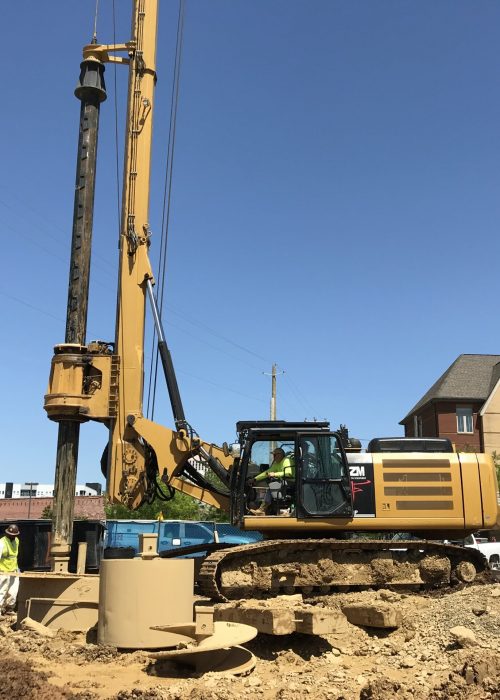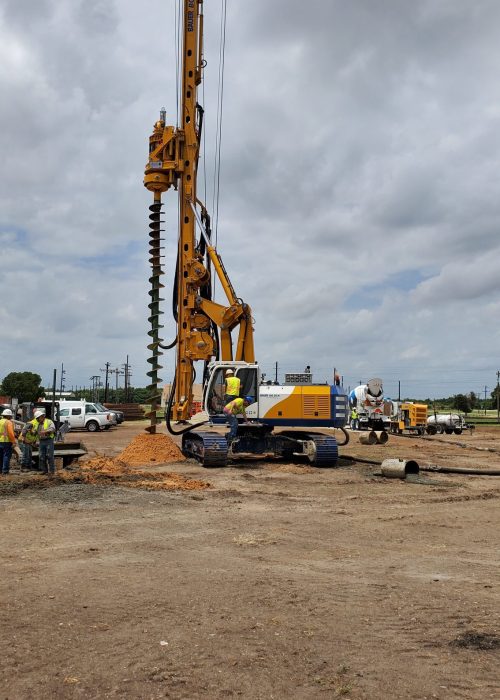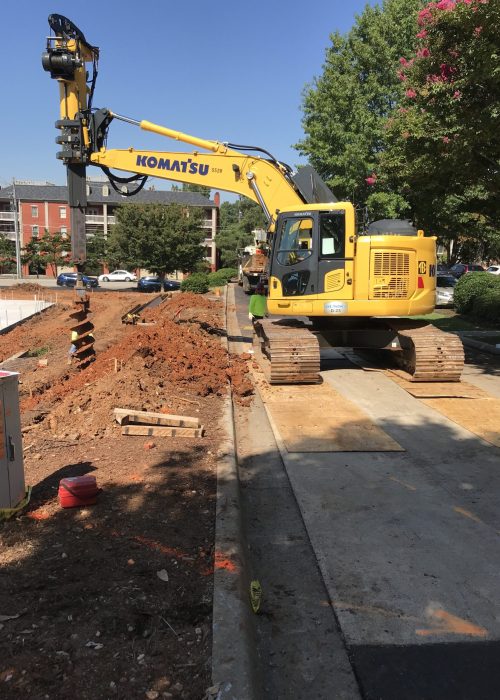Ground improvement is the reinforcing or treatment of in situ soil to increase bearing capacity or transfer load to a deeper bearing stratum. It can also involve the grouting of soil and rock utilizing cementitious or chemical grout to strengthen or fill voids in soil and rock. There are several types of ground improvement techniques, and they are site geology and structure loads. We will typically dictate the ground improvement technique they are site-specific based on the site geology and structure loads.
Vibratory Compaction can be used to increase bearing capacity, reduce settlement, mitigate liquefaction potential, and improve clean granular fill material. Vibratory compaction uses tooling and equipment similar to aggregate pier installation but does not rely on an aggregate to improve the ground. Vibratory Compaction is limited in application to relatively clean (minimal fines), non-cohesive material such as sand.
Permeation Grouting or Chemical Grouting refers to the use of certain chemicals such as polyurethanes, acrylates, acrylamides, or sodium silicates for structural improvement or seepage control. The appropriate chemical grout can produce excellent results in a variety of applications. Careful consideration must be given to the selection of the grout and the contractor selected to perform the work to maximize the benefit of the chemical grouting operation. Chemical grouts have been successfully utilized to completely permeate clean sands to fill voids within the treated profile. Hydroactive grouts are commonly used to minimize or completely stop seepage in and around existing structures.
Slurry Grouting or Cement Grouting is the general terminology applied to the placement of a cementitious binder such as cement, fly ash, or slag in a slurry form (typically binder and water only). Slurry grout can be placed under pressure (Pressure Grouting), gravity filling, or tremie placement depending on the application and requirements of the project. Slurry grouting is most commonly used in the industry to fill cracks and voids in rock formations to create a water cutoff or to increase capacity. Slurry grouting is also commonly used for the placement of grout in soil nail, micropile, and anchor applications. Slurry grouts are also used to fill voids directly beneath existing foundations to reestablish intimate contact with the subgrade (Contact Grouting). As with most grouting technologies, the type of binder and water-to-cement (w:c) ratio will determine the strength of the material after fully curing. Additives can be used to engineer the appropriate slurry for the application.
Compaction Grouting, also known as Low Mobility Grouting (LMG), uses volumetric displacement to improve in-situ soil conditions. A very low slump grout (usually 0” to 3” slump at the point of injection) is pumped in stages to displace the surrounding soil. Compaction grout typically combines sand, cement, gravel, and water. Ground improvement can be achieved by staging or sequencing the compaction grout locations. In some cases, primary, secondary, tertiary and even quaternary treatment locations may be considered to maximize the effectiveness of the compaction grouting program. Compaction grouting is also an excellent alternative for re-leveling structures, reinforcement of fine-grained soils, and void filling. Compaction grout mix designs can be altered to provide a wide range of unconfined compressive strengths depending on the project’s requirements.
Aggregate Piers are columns of compacted stone placed in situ which can be designed to reduce settlement, improve bearing capacity, mitigate liquefaction potential, and increase shear resistance. Aggregate piers can be installed by predrilling and placing the stone from the surface or by insertion of the tool and delivering the stone through an annulus to the tip of the tool without the need for predrilling. These installation techniques are commonly referred to as top feed or bottom feed respectively. In either case, the tool is raised and lowered as the stone is placed. This action, combined with vibration created by the tool, compacts the stone creating a densified column of rock. Aggregate piers can be used to improve the ground by volumetric displacement in granular soils or as reinforcement in cohesive soils.

Children’s Hospital | Downtown- Birmingham, AL

Texas A&M | College Station, TX

Chick-Fil-A | Huntsville, AL